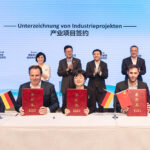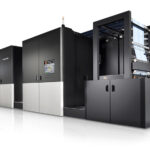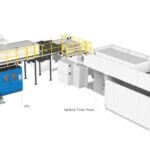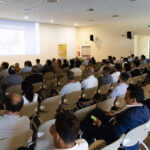The newly created print workshop of the Canadian Printability and Graphic Communications Institute(ICI) has equipped itself with a multi-process Varyflex V2 Omet printing press, which will be used for the development of new applications.
A brand new lab and equipped with state-of-the-art technologies for the Canadian Printability and Graphic Communications Institute (ICI), based in Montreal (Quebec). Inaugurated last November with a ceremony that involved hundreds of guests, it saw section heads and teacher-trainers committed to illustrating the many projects that will be carried out on the Varyflex V2 supplied by the Italian company Omet involving innovative printing applications, especially in electronics, and the relative prototyping. With this machine, it was underlined during the event, ICI can field an extraordinary configuration flexibility along with an ability to test and develop applications with the aim of providing industry immediately applicable solutions.

A unique facilities. The equipment developed by ICI at Omet’s Lecco works is truly one of a kind, namely a Varyflex V2 for in-line multi-process printing adapted to conform to the needs of the Institute and its partners. Its main features are the perfect interchangeability of print processes and maximum registration accuracy.
Moreover, it is a machine designed for production, and therefore not under-dimensioned, which required transport by sea in four fourteen metre long containers. «This is not just workshop equipment» stressed Régent Bernier, head of ICI’s flexography dept., explaining: «We wanted something that was as close as possible to what printers actually use, to be able to easily turn prototypes into working solutions».
Interchangeable processes and registration accuracy. Varyflex V2 stands out especially for its multi-process functions, ie the combination of different printing technologies on a single machine. It is in fact able to switch from screen- to gravure to flexographic printing in the desired order, with a unique flexibility.
«We will be able to print plastic films, thick cardboard or paper, and also use three different print processes in 5 units» says Bernier. On top of that, the machine is reconfigurable by adding new units, to allow ICI to expand their performance portfolio. The project team demanded absolute registration accuracy. Any changes needed to achieve the desired results will be made by Omet, who have signed a three-year partnership contract: «Together, we will push the registration accuracy to the technological limit» says Christine Canet, head of advisory services and applied research at ICI.
Lower production costs. According to Ms. Canet, machine efficiency provides economies of management that ensure process sustainability, bolstered in this case by the fact that the Varyflex V2 can print very different products on the same line in one pass.
«The flexibility of the printing process allows us to intervene exactly where needed» ICI , project manager Chloé Bois declares, «not to mention that Varyflex V2 also reduces ink consumption, working with small amounts and minimizing waste. Thus anyone carrying out tests at the Institute can recover their unused product, to everyone’s benefit».
The value of expertise. The experience of the Canadian institute in the graphics chain is decisive. «There will soon be new applications leading on from products under development, and our role is to get them to work in conditions of reproducibility» the experts say. «We have done print proofs for years: it is one of our strongpoints and this project – according Canet, who also works with the National Research Council (NRC) – demonstrates the sense of Canadian collaboration. Omet is involved as more than merely a supplier: rather more as a partner that will take part in the adventure for the next three years. Omet is a leader in its own right that has decided to invest in a highly specialized market», concludes the researcher.
Printing communication. The history of printing is intrinsically linked to the evolution of society because it enables the transmission of ideas, information access and the preservation of texts. This evolution is continuing over time and now opens up new possibilities, which turn the “medium” into a “smart” support with new features.
Flexible solar panels, batteries, sensors, lighting products, smart packaging and displays … can be made with printing processes combined with a flexible substrate, adopting new types of ink. ICI’s task is to experiment, test and verify their performance in all aspects of the printing process on Omet’s machine, with precise objectives. The challenges are many, such as, for example, be able to superimpose various types of inks to get a “multilayer” combination with new properties, or develop packaging that communicates with smart phones: a technology called Near Field Communication (NFC), which will be based on printed microchips.
This project is the result of the joint work of the Canadian Printability and Graphic Communications Institute, Omet R&D, Matik (Omet distributor for North America) and the sales agents of Omet Italy; it is funded by the Canadian Foundation for Innovation, the Ministry of Higher Education Research, Science and Technology of Canada and the Canadian National Research Council (CNRC). ICI was established in 1992 by Ahuntsic Collège, a public pre-university research centre of Quebec, and is recognized has been acknowledged as a university technology transfer center since 1996.
Processi intercambiabili e precisione di registro. Varyflex V2 si distingue soprattutto per le funzionalità multi-processo, ossia per l’unione di diverse tecnologie di stampa su una singola macchina. È infatti in grado di passare dalla serigrafia alla rotocalco o flessografia nell’ordine desiderato, con una flessibilità unica.
«Saremo in grado di stampare film plastici sottili o cartone a elevato spessore o la carta, e di utilizzare anche tre diversi processi di stampa in 5 gruppi», spiega Bernier. Inoltre, la macchina è riconfigurabile aggiungendo nuove unità, per consentire a ICI di ampliare il portafoglio di prestazioni. Il team di progetto ha richiesto una precisione di registro assoluta. Eventuali modifiche necessarie a raggiungere i risultati desiderati saranno apportate da Omet, impegnata in un contratto di partenariato triennale: «Insieme, spingeremo la precisione di registro al limite della tecnologia”, dichiara al riguardo Christine Canet, direttore dei servizi di consulenza e ricerca applicata di ICI.
Minori costi di produzione. Secondo la signora Canet, le economie di gestione necessarie a garantire la sostenibilità dei processi originano dall’efficienza e, in questo caso, dal fatto che la Varyflex V2 può stampare prodotti anche molto diversi sulla stessa linea, in un solo passaggio.
«La flessibilità dei processi di stampa ci permette di agire esattamente dove è necessario» considera a sua volta Chloé Bois, responsabile di progetto dell’ICI, «senza contare che Varyflex V2 permette di ridurre anche il consumo d’inchiostro, lavorando con piccole quantità e minimizzando gli scarti. In questo modo, chi effettua i test presso l’Istituto possono recuperare il prodotto non utilizzato, con grande vantaggio».
Il valore delle competenze. L’esperienza dell’Istituto canadese nella filiera grafica è determinante. «Ci saranno presto nuove applicazioni, con prodotti in fase di sviluppo, e il nostro ruolo è di farli funzionare in condizioni di riproducibilità» affermano gli esperti. «Abbiamo effettuato prove di stampa per anni: è uno dei nostri punti di forza e questo progetto – secondo Canet, che collabora anche con il Consiglio Nazionale delle Ricerche (NRC) – dimostra il senso di collaborazione canadese. Omet vi è coinvolta più che come semplice fornitore: è piuttosto un partner che parteciperà all’avventura per i prossimi tre anni. È un leader, che ha deciso di investire in un mercato a forte specializzazione» conclude la ricercatrice.
Stampare comunicazione. La storia della stampa è intrinsecamente legata all’evoluzione della società perché consente la trasmissione di idee, l’accesso alle informazioni e la conservazione dei testi. Quest’evoluzione continua nel tempo e oggi apre nuove possibilità, che trasformano il “mezzo” in supporto “intelligente” con nuove funzionalità.
Pannelli solari flessibili, batterie, sensori, prodotti per l’illuminazione, imballaggi intelligenti e display… possono essere realizzati con processi di stampa combinati su un supporto flessibile, adottando nuovi tipi di inchiostro. Compitodi ICI è di sperimentarli, testarli e controllarne il comportamento in tutti gli aspetti del processo di stampa, sulla macchina della Omet, con precisi obiettivi. Molte le sfide, come ad esempio, riuscire a sovrapporre vari tipi di inchiostri per ottenere una combinazione “multistrato” con nuove proprietà, o sviluppare imballaggi con capacità comunicative verso gli smart phones: una tecnologia, denominata Near Field Communication (NFC) che si baserà su microchip stampati.
Questo progetto si deve al avoro congiunto di: Istituto Canadese per la Comunicazione Grafica e Stampata, R&S Omet, Matik (distributore di Omet per l’America settentrionale) e degli addetti commerciali di Omet Italia; è finanziato dalla Fondazione canadese per l’innovazione, dal Ministero dell’Istruzione Superiore di Ricerca, Scienza e Tecnologia del Canada e dal Consiglio Nazionale delle Ricerche del Canada (CNCR). L’ICI è stato creato nel 1992 dall’Ahuntsic Collège, un polo pre-universitario pubblico del Québec, ed è riconosciuto come centro di trasferimento tecnologico universitario dal 1996.














